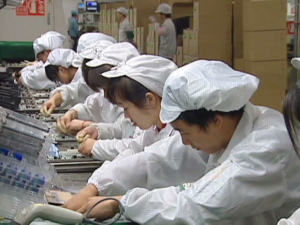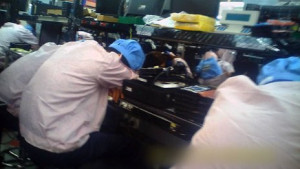
Apple made headlines last week when it announced record-setting profits from its most recent business quarter (Oct-Dec 2014, Apple’s fiscal Q1).
$74.6 billion revenue
$18 billion in pure profit
$142 billion net cash reserves
74.5 million iPhones sold
Apple fiscal Q1 numbers, as reported by BBC
These figures blew past many analysts’ predictions and Apple’s previous records for the same quarter last year.
On the micro level, there are also some important numbers to pay attention to:
Number of workers in “final assembly” plants: 500,000
Hours worked per week: 72 – 105
Hours are higher during peak production seasons. The following calculations are based on 84 hour work weeks. (12 hour days, 7 days per week).
Monthly base wage: $244 (1530 yuan)
Overall monthly wage (including overtime): $582 (3650 yuan)
Hourly wage: $1.62 per hour (10.13 yuan/hour)
Labor cost per iPhone assembled: $0.27
Recommended living wage: $725 (4537 yuan)
Calculated by Asia Floor Wage for a 48 hour work week.
Recommended Hourly Wage: $3.77 (23.6 yuan)
Recommended labor cost per iPhone assembled: $0.63
Cost difference for assembly labor per iPhone: $0.36
Exchange rate used: $1 = 6.26 yuan
Explanation of Calculations:

Young workers assembling iPhones. Credit: SACOM
According to Apple, 1.5 million people work in their supply chain, a third of which work in “final assembly” mega-factories. This means that during the same three months Apple set these financial records, 1 million Apple workers made the parts for these phones and 500,000 put them together.
Workers at one assembly factory make base wages of 1530 yuan ($244) per month (This is the minimum wage in Suzhou, China). With lots overtime, workers can increase these earnings to roughly 3650 yuan ($582) per month, according to a 2014 investigation by Students and Scholars Against Corporate Misbehaviour (SACOM). This was at Pegatron, one of Apple’s main suppliers in China, which handles the final assembly of Apple’s iPhones. Other final assembly plants include Foxconn and Quanta.[1]
The living wage in China, as calculated by the Asia Floor Wage in 2013, is approximately 4537 yuan ($725 USD, PPP). This is based on working 48 hours per week at a rate of about $3.77 per hour.
However, workers in Apple’s supplier factories, do not work 48 hours per week, especially during peak production times. SACOM’s investigation found that some workers at Pegatron worked for 10 weeks without a rest day and often for 12-15 hours a day, sometimes up to 17-18 hours a day. This means that during peak production time, workers at Pegatron were working between 84 and 105 hours per week. This is more than double a typical workweek around the world.
Taking a conservative estimate of (12 hours/day, 30 days per month) workers earn approximately 10.13 yuan/hour, or roughly $1.62 per hour. This is less than half the recommended living wage of about 3.77 per hour.
According to a 2008 study published by MIT’s Sloan school of Business, which looked at the value chain of iPods, the assembly time required for one device was 10 minutes, or six iPods per hour. Which means, if comparable, the cost of labor per iPhone assembled is roughly 27 cents.[2]
Apple’s profit margin, or the money in pure profit it makes on every iPhone sold, is 39.9%, according to BBC. The industry average for consumer electronics is below 10%, according to Standard & Poor’s. The iPhone 6 costs between $199 and $749 at Apple’s online store, which means that depending on which phone you buy and the amount of storage you elect, Apple could be pocketing somewhere between $79 and $299 in profit. Apple’s margins are high for any sector, let alone a sector that requires the work of millions of human beings to make a product. The per piece labor of just $0.27 (for assembly) helps explain how Apple is able to achieve these remarkable margins.
Labor is one of the highest costs that any business will incur in any sector. One of the reasons, and usually the primary reason, a business may choose to manufacture in one particular country is the relative “cheapness” of labor costs there—meaning low wages. But at what point does the pursuit of lower wages move from a “savvy business scheme” to full-on exploitation?
In China, where Apple’s iPhones are made, wages are relatively low. So low in fact that workers must rely on overtime pay to get by. Electronics brands argue that workers like to work overtime so they can save for their future, but if workers base wages were raised to provide a living wage to begin with, would they elect to work such exhausting hours?
In these mega-electronics factories, there are typically 2 shifts, day and night. Workers either work 12 hours during the day, or 12 hours straight through the night. This often does not include time that workers may need to dress/undress, pass through security, or attend pre- or post-shift meetings. With either shift, little time is left over for recreation, personal development, or even rest.

Exhausted from long shift, many workers fall asleep on the job. Credit: BBC Panorama
In fact, in a recent BBC expose of Pegatron, one of the most apparent problems was the amount of workers falling asleep on the job, some while operating or working near dangerous equipment.
A recent letter written by nine non-profit and workers organizations called on brands to address the poverty wages in the manufacturing sector by paying “living wages, according to a credible benchmark, throughout their operations and supply chains… and structur[ing] their business relationships with suppliers, both in terms of price and volume, in such a way that living wages can feasibly be paid.” For electronics in China, this would mean paying the living wage for 48 hours of work–not poverty wages that rely on excessive overtime to get even close to this figure.
$1.62 per hour, or less, is just too little to compensate someone who works six+ days a week, for 12+ hours a day, in exhausting and often dangerous conditions. As documented by Green America and allies, toxins are prevalent in Apple supplier factories (many of which are suppliers for Apple’s competitors as well), and workers are developing cancer and other devastating diseases as a result. Apple announced in 2014 that it would ban two harmful chemicals in its final assembly plants to protect workers, however, there are hundreds of hazardous chemicals used in electronics manufacturing, particularly at parts and semiconductor manufacturers.

36 cents, the amount it would cost Apple per iPhone to pay final assembly workers a living wage
The trade-off workers in these factories must make for these meager wages is one that arguably no worker in the United States would willingly accept.
So when does the pursuit of lower wages move from a “savvy business scheme” to full-on exploitation? In the case of Apple, who made $18 billion in profit last quarter and who could spend just 36 cents more per iPhone to ensure living wages, it’s painfully clear it has crossed this line. And what better company to fix this error than the most profitable company in the history of the world?
[1] In 2012, the New York Times did a thorough job analyzing workers hourly wages at Foxconn, another final assembly factory.
[2] This estimation is imperfect. It does not include the cost of labor further down the supply chain, at parts manufacturing plants. (Though the MIT study estimates these workers earn even less than assembly workers, due to greater competition among parts manufacturers). It also bases the assembly time required on iPods, not iPhones. Finally, it relies on exchanging yuan to US dollars, a rate that is not constant. ($1=6.26 yuan was the exchange rate at the time of writing.)






